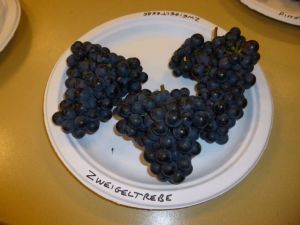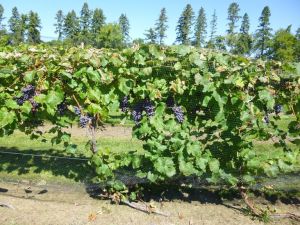University of Minnesota Fall Grape Tour
This is a short review of my visit to the Fall Tour at the University of Minnesota (U of M) Horticultural Research Center on September 6, 2014.

Peter Hemstad (left) addresses the crowd at the University of Minnesota Open House on September 6th. The plates on the table each display a different variety of grape that is grown at the University.
My main interest was to see how vinifera varieties and other “not hardy” varieties survived the 2014 polar vortex using the “J-system” vine training techniques used at the U of M vineyard. And I was impressed by such a high percentage of grape survival and production.
As always, Peter Hemstad, grape scientist at the U of M, perfectly presented all grapes and placed each one on long tables for viewing. These included Vinifera, seedless grapes and different types of hybrids.
My attention turned to Vinifera like hybrids (Solaris, Dornfelder, Regent), and the Zweigeltrebe grape. Solaris is not a remarkable white wine grape, in my opinion. I did not have a chance to taste the Solaris wine, but it is good for making a plain white table wine.
Some of the U of M varieties have much more potential than Solaris, in my opinion; most notably MN 1188 and MN 1241. MN 1188 has a nice fruity, lemony taste. And MN 1241 has a very pleasant Muscat aroma.
The other variety which I would like to mention is Zweigeltrebe. It really merits attention. That’s because Zweigeltrebe has noticeable amounts of tannins, probably the highest amount among all grapes presented at the U of M event.
Zweigeltrebe was created in 1922 by crossing two Vinifera varieties, but only now is the grape expanding through Europe and the U.S . See: (http://zweigeltproject.com/

Zweigeltrebe- the pronunciation is subject to debate but the grape has great potential in the Midwest.
Dornfelder is a nice looking grape with big clusters. I agree with Peter Hemstad – the size of Dornfleder clusters and berries are more similar to table seeded grapes. In my opinion, the amounts of tannins are minimal. The Dornfelder wine sold in our local liquor stores presents itself to me as a regular red table wine.
Regent has more noticeable tannins than Dornfelder, but less than Zweigeltrebe. Perhaps Regent has some potential for expanding in certain areas in the U.S. But for me, Zweigeltrebe may develop more interest among U.S . winemakers, or at least grapebreeders.
Among all Muscats presented at the U of M, Muscat Ottonel had the most pronounced aroma, which is good to know for further breeding efforts. From my experience, if a grape conveys a certain aroma, then usually the aroma will show up in the wine too.
For the first time, I tasted Zilga which was also showcased on the big viewing table. I agree with Peter – it has some potential from a hardiness point of view. Zilga also has a fruity aroma combined with very noticeable tannins. It will be interesting to see how it turns out as a finished wine.
I also liked the white seedless grapes called Neptune. This grape has nicely sized clusters, which are easy for consumers to hold in their hands. This is very important at the grocery store. Grapes do not need to have extremely big clusters; just nicely sized berries, nice color and a very good taste too.
Regarding Centennial grapes – they do have huge clusters- these grapes are prone to cracking and rotting after the climatic conditions of this year. I was a little disappointed in this variety.
The grape table presentation was followed by a walking tour through different parts of the U of M vineyard. Vinifera and not hardy hybrid varieties were growing on the University’s J-training system. Hardy hybrids were growing on many different training systems. The University is also doing research to determine genetic markers for different diseases.

The “J training” grape growing technique employed at the U of M is credited with helping vines survive the brutal winter of 2013 and 2014.
Photos by Alexandru Bortnov.



Hi, i would love to get a link to the file for making your own concrete posts (for vineyard). The link in the article is dead.
Thanks!
I’ve wondered about the potential of Zweigelt for years. If I remember write, there was a genetic test on it and found out it was actually a hybrid. If memory serves, St.Laurent was tested and had a small amount of hybrid genetics. This explains why Zweigelt seems to be a little bit more cold hardy than pretty much any other vinifera and the leaves too, look like something a little bit in between something pure vinifera and N.american hybrids.
Jon , Thank you for your comments. Yes, some debates existing about parentage of St.Laurent, but they are leaning more towards of a natural seedling of Vinifera Pinot Noir grape. Even the other synonym of St.Laurent is a Pinot Saint Laurent. According to Vitis International Variety Catalogue (VIVC) Zweigelt is a pure Vinifera variety based on two Vinifera cultivars St.Laurent and Blaufraenkisch ( http://www.vivc.de/datasheet/dataResult.php?data=13484 ). Last update for that grape was done on 09.29.2014. Marker data on St.Laurent grape, according to VIVC, also showing that it is a Vinifera variety.
Zweigelt (aka Zweigeltrebe) definitely merit our attention as a high quality nicely tannic grape.